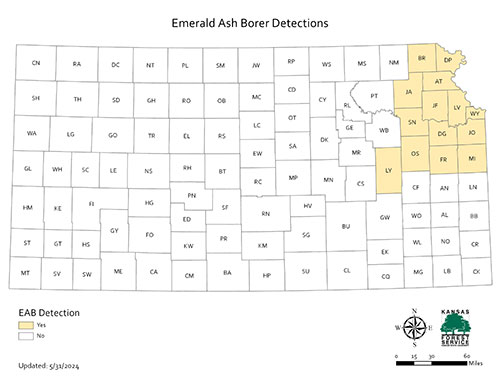Emerald Ash Borer detected in Lyon County
Kansas Forest Service urges tree diversity to mitigate impacts of the wood-boring beetle
At a glance: The Kansas Department of Agriculture has confirmed the presence of the Emerald Ash Borer in Emporia, making Lyon County the 14th county in Kansas confirmed to have the invasive insect.
More information: Matt Norville, 785-473-1064, mnorville@ksu.edu
Photos: Emerald Ash Borer damage | Emerald Ash Borer in Kansas (Map)
Related: Recommended Trees (Kansas) | Emerald Ash Borer spread in Kansas (map)
May 31, 2024
K-State Research and Extension news service
MANHATTAN, Kan. – The Kansas Department of Agriculture has confirmed the presence of the Emerald Ash Borer in Emporia last week, making Lyon County the 14th county in Kansas confirmed to have the invasive insect.
![]() EAB was first suspected in the United States in the 1990s, though not detected or discovered until 2002. Since then, the beetle is responsible for the destruction of tens of millions of ash trees in 30 states (including more than 40 million in Michigan alone), according to the USDA’s Animal and Plant Health Inspection Service. The pest was first discovered in Kansas in 2012 in Wyandotte County.
EAB was first suspected in the United States in the 1990s, though not detected or discovered until 2002. Since then, the beetle is responsible for the destruction of tens of millions of ash trees in 30 states (including more than 40 million in Michigan alone), according to the USDA’s Animal and Plant Health Inspection Service. The pest was first discovered in Kansas in 2012 in Wyandotte County.
At right: Emerald Ash Borer damage on tree limb | Download this photo
On May 24th, the Kansas Department of Agriculture officially detected EAB in Emporia, although it was suspected in Lyon County for much longer.
Matt Norville, the community forestry coordinator for the Kansas Forest Service, shared the reason for the delay between suspecting EAB and officially detecting the species.
“In order to officially confirm EAB, the Kansas Department of Agriculture requires an adult or larvae specimen,” he said. “It can be challenging for foresters or arborists working in these communities who may see declining ash and the galleries the insects leave behind, but detecting the actual insect is essential to making the call that it is officially in the county.”
 The Emerald Ash Borer – as its name suggests – is a green invasive, wood-boring beetle that kills ash trees by eating tissues under the bark. Adults are known to emerge in mid- to late-May from infestations to the trees the previous year and lay their eggs shortly thereafter.
The Emerald Ash Borer – as its name suggests – is a green invasive, wood-boring beetle that kills ash trees by eating tissues under the bark. Adults are known to emerge in mid- to late-May from infestations to the trees the previous year and lay their eggs shortly thereafter.
The resulting larvae bore into the ash tree and feed under the bark, leaving visible tracks underneath. Small trees can die as soon as 1-2 years after infestation, while larger infested trees may survive 3-4 years.
“Trees can tolerate borer activity for a few years, but without treatment they will eventually decline,” Norville said.
But Norville says early detection and proper treatment can save infected trees. He recommends treatment as soon as possible by a licensed pesticide applicator. Treatment can be done by landowners on smaller trees, but smaller trees are better candidates for removal and replacement as treatment would need to continue indefinitely.
“We mostly want to encourage communities to plan for pests and diseases and increase their community tree diversity,” Norville said. “We’ve seen how diseases like Dutch elm disease and pests like emerald ash borer can have a devastating impact on communities that have an abundance of one type of tree. Communities that plan for tree removal due to age and overall health should be planting replacement trees that are a mix of native and proven cultivars.”
For lists of recommended trees for your part of the state, Norville encouraged Kansans to visit https://www.kansasforests.org/resources/recommendedtreesandshrubs.html.
To learn more about where EAB has spread and treatment options for homeowners visit: https://www.kansasforests.org/forest_health/current_pests/emeraldashborer.html.
***

K‑State Research and Extension is a short name for the Kansas State University Agricultural Experiment Station and Cooperative Extension Service, a program designed to generate and distribute useful knowledge for the well‑being of Kansans. Supported by county, state, federal and private funds, the program has county extension offices, experiment fields, area extension offices and regional research centers statewide. Its headquarters is on the K‑State campus in Manhattan. For more information, visit www.ksre.ksu.edu. K-State Research and Extension is an equal opportunity provider and employer.